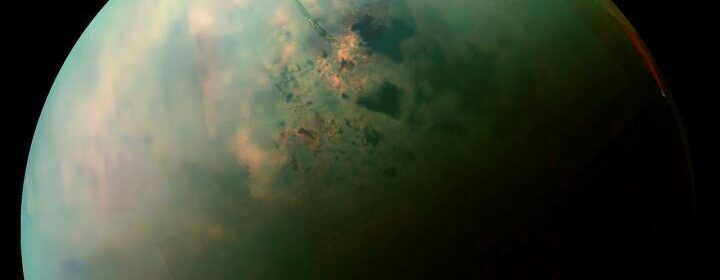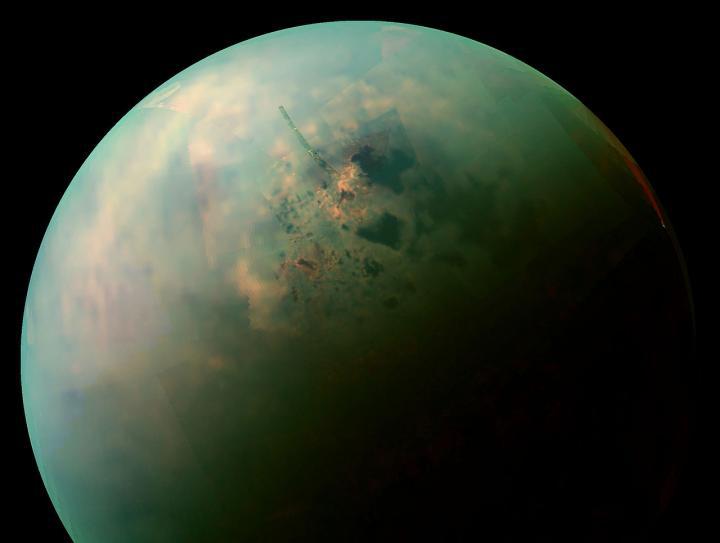‘Bathtub rings’ around Titan’s lakes might be made of alien crystals

‘Bathtub rings’ around Titan’s lakes might be made of alien crystals

Titan is a weird place. Bigger than the planet Mercury, it has an atmosphere, and it rains and snows. There are liquid lakes and oceans of methane and ethane on the surface, but of water underground.
Titan also has strange minerals that don’t exist on Earth, according to research presented Monday at Seattle’s 2019 Astrobiology Science Conference.
These minerals, suspected to form rings around Titan’s lakes, include a co-crystal made of solid acetylene and butane. Yes, Titan is a strange place indeed. While acetylene and butane are a gas on Earth (often found in camping stoves), they are solid on Titan, and combine to form crystals, the new research found.

What do we know about Titan and its lakes?
Titan, the biggest of Saturn’s 62 moons and the second-largest moon in the solar system after Ganymede at Jupiter, has an atmosphere of 98% nitrogen and 2% methane. Here, with just 1% of the amount of sunlight Earth gets, the average surface temperature is −290 °F/−179 °C.
We know that Titan’s lakes are filled with liquid hydrocarbons, and images and data from NASA’s Cassini mission showed that lakes in the moon’s dry regions near the equator display bright tell-take signs of evaporated material left behind.

How to make ‘hydrocarbon soup’
Morgan Cable of NASA’s Jet Propulsion Laboratory at the California Institute of Technology describes them as being like rings on a bathtub. Her team set about re-creating Titan-Esque conditions in their laboratory, essentially making a “hydrocarbon soup.”
A cryostat was filled with liquid nitrogen, then warmed slightly so the nitrogen turned to gas. The result? A mini Titan atmosphere.
Then they introduced methane and ethane and observed what formed. First came benzene crystals, a component of gasoline, but with ethane molecules inside to create a co-crystal. The researchers then discovered the acetylene and butane co-crystal.
What is an acetylene-butane co-crystal?
A new and potentially the most common molecular mineral on Titan, the acetylene-butane co-crystal produced in the lab is stable at Titan surface temperature. Cable thinks that the acetylene and butane co-crystal is probably a lot more common on Titan than benzene crystals simply because acetylene and butane are believed to be more common on the moon’s frigid surface. “The acetylene-butane co-crystal may be ubiquitous [in some regions] of Titan’s surface,” says the paper.
Why does it make ‘bathtub rings?’
Acetylene and butane both dissolve well in liquid methane and ethane compared to other molecules. So in much the same way as the shores of lakes and seas on Earth form salty crusts as water evaporates, the acetylene-butane co-crystals might form rings around Titan’s lakes as the liquid hydrocarbons evaporate and the minerals drop out, argues the paper.
Is there any proof this co-crystal exists on Titan?
“We don’t know yet if we have these bathtub rings,” says Cable. “It’s hard to see through Titan’s hazy atmosphere.” That’s a real challenge with Titan; its methane and ethane clouds make it hard to get anything from telescope views of the moon. Cue Dragonfly, a mission from Johns Hopkins University Applied Physics Laboratory (APL) that’s under consideration for a NASA New Frontiers mission. It would take advantage of Titan’s buoyant atmosphere to fly a quad-copter between various sites on the moon’s surface. It’s pencilled in for launch in 2025, reaching Titan around 2034.

Why is this important?
Life, but not as we know it. “Differences in physical or mechanical properties may lead to chemical gradients on Titan, which life could potentially exploit,” says the paper. “It is possible that acetylene-based co-crystals might be a mechanism for storing acetylene, in a manner similar to how carbon dioxide is stored in carbonate deposits on Earth, where it might be more readily accessible to a putative microbial community.”
What did Huygens find?
Huygens was a small probe from the European Space Agency sent to the Saturn system with the Cassini probe. In 2005 it descended to the surface, shooting an incredible video and picking-up radio signals that suggest that Titan has a large underground liquid ocean. That’s why Titan is already on the “watch list” for places that could have the conditions for the kind of life Earth has produced.
However, its liquid hydrocarbon surface is so very alien to Earth’s that a completely different kind of mechanism for life is what astrobiologists are searching for.
Since it has a place in the search for life as we know it, and life not as we know it, Titan is proving something of an astrobiological playground.
The presentation at the 2019 Astrobiology Science Conference was based on a paper entitled “The Acetylene-Butane Co-Crystal: A Potentially Abundant Molecular Mineral on Titan” by Morgan L Cable, Tuan Hoang Vu and Robert P Hodyss, NASA Jet Propulsion Laboratory, Pasadena, CA, United States, and Helen Elizabeth Maynard-Casely, Australian Nuclear Science and Technology Organization, Kirrawee, NSW, Australia.